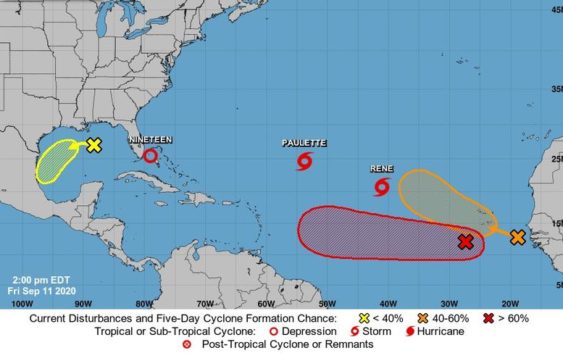- Hays County emergency alerts cause confusion during Tuesday's wildfires
- Tuesday's wildfires scorched more than 500 acres in south Bexar County
- How big were this week's wildfires in Bexar County?
- Crews contain wildfire in southeast Williamson County
- Wildfire contained to 300 acres in northwest Matagorda County
Hurricane Experts Monitor A New Storm System Off Mexico's Gulf Coast

A small collection of storms off Mexico’s Gulf coast attracted the attention of the National Hurricane Center on Thursday, and forecasters warned the storm could soon form into a tropical depression or tropical storm before the weekend.
“A well-defined area of low pressure over the southwestern Gulf will meander over the southwestern Gulf for the next day or so before moving slowly northward to northeastward on Fri and Sat,” an NHC analysis explained.
It was not yet clear how the system could impact the Texas coast, aside from the expected higher surf and storm surge.
If it grew into a tropical storm, the NHC would name it Wilfred. That is the last name on the NHC’s 2020 list of “Tropical Cyclone Names.” Any other storms that emerge in the Atlantic, Gulf and Caribbean will receive names from the Greek alphabet.
The development in the Gulf of Mexico emerged near the end of a historically busy week in the Atlantic, Caribbean and Gulf regions.
Sally made a dangerously slow landfall near Gulf Shores, Ala., on Wednesday morning as a Category 2 hurricane, flooded several states throughout the southeastern U.S. and killed at least one person in Alabama.
By Thursday afternoon, the NHC had issued its final advisory on Sally — essentially closing the books on the drama — and officially classified it as a post-tropical depression. Sally’s remnants were expected to continue flooding Georgia and the Carolinas.
NPR reported that Sally will remain notable not just because of its intense flooding — measured in some places in feet rather than inches — but also because it surprised experts and residents both by growing quickly in the final moments before landfall and by its sudden shift to the east, from Louisiana to Alabama.
The NHC also monitored Teddy, which grew to a Category 3 hurricane and threatened Bermuda, and Vicky, a tropical depression that was expected to dissipate over the central Atlantic by Thursday evening. Also, a weak system southwest of the Cabo Verde Islands off West Africa could grow into a tropical depression this weekend.
[12pm AST Sep 17] We’re monitoring the #GOESEast mesoscale imagery of Major Hurricane #Teddy as it continues to intensify.
These high resolution images are updated every minute, allowing meteorologists to assess quick changes in storm structure. pic.twitter.com/Eth3xWOibx
— NHC_TAFB (@NHC_TAFB) September 17, 2020
TPR was founded by and is supported by our community. If you value our commitment to the highest standards of responsible journalism and are able to do so, please consider making your gift of support today.